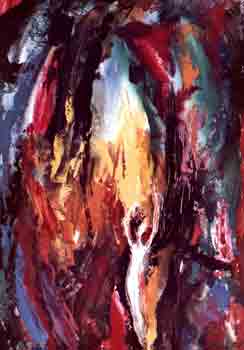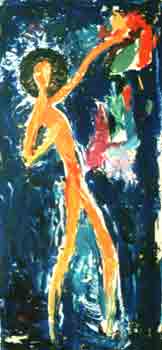Two sketches to "Artist"


Professor ZHAN PERUS, the critic
Clermon, France, 1972.
Printed in magazine "Europe" in 1972.
In Russian it is printed in the newspaper "Science"
The Kazan branch of the Academy of sciences of the USSR
12.06.89, 21
Translated from French. To see the text in language of the
original, click
here.
Valius
In the last year in Moscow artist Pjotr Valius has died of a cancer. The Parisian judges of painting remember, certainly, his works at the first post-war exhibition of the Soviet painting in 1967. His participation in this exhibition was rather modest: the flowers made by distemper. Works almost have been immediately removed (bought), but the press, in particular "Leter Frances", has noted their high worthiness. In these distempers, amazingly quivering on colour, especially touched connection of bright freshness of a life and sensation of its fragility, so characteristic for creative individuality of this artist.
Father Valius comes from Baltic, mother - Russian. Peter Valius was born and lived in Moscow. To be the artist he became late. His parents were pharmacists, they did not approve desire of the son to paint, and he have received a technical education, became the builder. Only after war he has dared to leave the profession and, with help of the friends who trusted in his talent, has completely devoted itself to painting. Within 15 years he wrote in a quiet and worthy manner, not causing censures and especially not differing in the general stream of the Soviet painting. He went, perhaps, even behind of others: his individuality was expressed more likely in tenderness, than in force. And only in 1963 he has sharply changed a manner and has painted large canvases which can be named philosophical (in that sense, in what this word applicable to Van Gogh's works), and these canvases have put him in one line with the most outstanding artists of our century.
Valius was the friendly and affable person: he has revived tradition a little bit forgotten in Moscow, having opened doors of the house for all fans of art. It has allowed him to create privately an atmosphere of spiritual dialogue between the artist and public in which he felt an imperative need. The widow and son of Valius, revering his memory, continue once in a week to accept fans of painting in a studio which has been given to the artist and of which he has not had time to take advantage. He would find open space in it, so to him necessary last years jf life when his art became monumental. Hanging on walls of an extensive studio, his canvases distinctly and expressively in language of painting, without any allegorical didactics bear to the spectator precepts of the artist.
Each of canvases represents reflection in plastic, reflects tragic contradictions of our time and their comprehension by the artist who passionately loved people and life. Sharply contrast colors of Valius persistently enter into consciousness of the spectator, not allowing him to evade from the represented problem: here war – is not war of horrors and heroism, but the responsibility of the conceiving person before the terrible fire reducing to ashes all that was kind and human. Or removal from a cross - not tormented body supported by sobbing women, not an eternal lesson of compassion and love: we see deathly white body, foots outside a canvas, perhaps still nailed to a cross; abandoned by everybody, it lays backwards on the black ground among chaos - really his sufferings were vain? Or the fragile female image, glowing in the cleanliness, covered and crushed in huge black weight of violence and obscurantism - she will revive! Or image of motherhood, but not triumphing and happy: The female body written in monotonous dark red tones on a contrast green background, draws a long arabesque, closing in itself an embryo and protecting weak sprout of life …
Pictures of Valius are easily accessible to understanding. Certainly, words can not express painting, besides, that it is pure plastic, nothing borrowing from a word, but its symbolical sense is clear. I would like to tell even only about one of the works of the artist which has been carried out by him in an extreme creative voltage of last months of a life: for one last month before death he has written 9 large canvases. I shall tell about a picture which appears at us as a result of all life of the artist. On lilac, paste painted, bubbling disturbing background as a stormy sea, a blowing up fog or the infernal river are represented two partially immersed figures; both are written in intensive red color - color of a life - and are very expressive: one of them, placed on the second plan, seems wounded, another, in the foreground, was straightened in a pose of a challenge; between them and above them we see the third figure, light going from him lights up heads of two first. The person it or or something other, glowing with all tones of yellow color, it seems to be the boiling sun sparkling above our tragic world! And whether color is materialization of an inner world of the artist, plastic expression of an idea, conscience, poetry? And, apparently, the artist has expressed in this creation his understanding of the purpose of Art.
Language of Valius as any poetic language, has the secrets. Freedom and oppression, a life and death battle there in all variety of warm and cold tones. But what designates this lilac disk appearing, as a secret planet, on many canvases? And why almost in each picture among gloomy abyss and poured dark tones of a background suddenly there are a small patch of light of white or yellow color? It is possible to guess only. I shall notice only, that in the picturesque manner of Valius itself there is something not finished. All his works were carried out at once in one impulse, in some hours. The paint imposed by a dense stream as if flows, flatted with putty knife, coils under stroke of a brush. There is nothing final or fixed. The world is created and transformed for our eyes. Visible to an eye the impulse of creative reflection overcomes during work antagonism of reality - life, death - and finds in struggle the supreme life. Artist carries away the spectator. This creative impulse expresses more, than victory of Valius over own death. He persistently and with trust calls people of a tragic century to realize their responsibility which is not only the means to rescue dignity, love, beauty, all creations of human spirit, but, today, the means to rescue any life on the Earth. Painting of Pjotr Valius mobilize people for struggle for a life. This painting is the important and useful reminder for the artist of the West: art should not go in void and abstraction. Language inherent in it is capable to express the deepest reflection, the highest idea, and remain human.